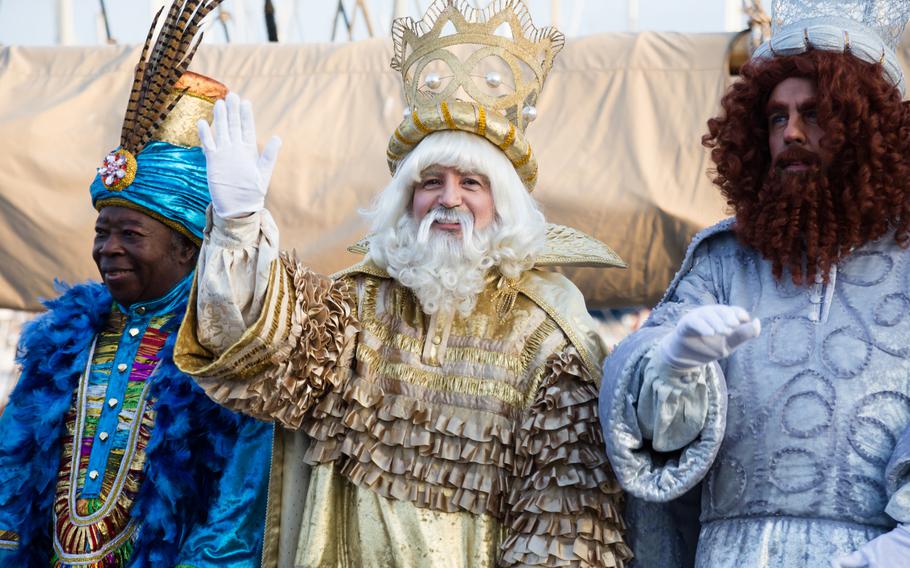
In Barcelona, the Magi arrive at port aboard a ship as part of Spain’s Three Kings Day festivities. (iStock)
Christmas has come and gone, but celebrations related to Christ’s birth aren’t over just yet. In many parts of Europe, Epiphany, or Three King’s Day, is cause for excitement, particularly among children, who will be hoping for presents arriving by special means of delivery.
Italy
The religious feast of the Epiphany on Jan. 6 is a public holiday and the day of a folkloric tradition that fills children with wonder and delight. According to one version of the legend, as the Three Wise Men were making their way toward Bethlehem, they encountered an old woman, whom they invited to accompany them on their journey to the site of Jesus’ birth. As she was too busy with her housework, she refused to come along, but soon regretted having turned down the opportunity. As she searched in vain for the baby of whom the Wise Men had spoken, she gave away the presents she’d prepared to other children instead. Throughout Italy, children hang out their stockings on the night of Jan. 5, in hopes that La Befana, traveling upon her broom, will reward them with toys and treats. A number of other activities are held to mark the day.
In Rome, Piazza Navona serves as one of the central gathering points on Jan. 6. Here, on the last day of the Christmas market that bears her name, families and friends will gather for one last round of seasonal treats and holiday cheer, and Befana herself will make an appearance. Also on the day, a celebration titled “Viva La Befana” sees a historical parade get underway from 10 a.m. along the Via della Conciliazione. Musicians, majorettes, flag-wavers and other figures clad in historical costume are accompanied by horses and animals associated with the nativity scene. The spectacle reaches its finale in St. Peter’s Square, where Pope Francis presides over the midday Angelus benediction. Following the Angelus, the three Magi present their symbolic gifts to the Pope. Online: tinyurl.com/59zv9ayh
Venice celebrates La Befana on its waterfront. On the morning of Jan. 6, members of the city’s oldest rowing club, the Bucintoro, don witches’ costumes before taking part in a regatta. The waterborne procession of participants arrives at the Rialto Bridge, from which dangles a gigantic stocking, at 10:30 a.m., and the races get underway shortly thereafter. Online: tinyurl.com/24v77cns
One Italian town is as closely associated with La Befana as the North Pole is with Santa Claus. Urbania, a town in the northern Marche region, in the province of Pesaro-Urbino, is the site of a celebration and spectacle for all ages. The thousands of stockings hung about town create the perfect backdrop for dancing witches and a pair of particularly acrobatic ones displaying their high-wire skills from the bell tower. Street theater and stands serving regional fare complete the festive atmosphere of “Befana World.” Festivities take place Jan. 3-6; adults pay 6 euros for entry while children under the age of 10 enter for free. Online: festadellabefana.com
Until recently, Verona had celebrated Jan. 6 with a ceremony known as “rogo della vecia,” or burning of the old woman, which involved setting alight an effigy. The revamped celebration still sees the procession of the Magi, albeit without the live animals of yore, preceded by fire and magic shows, circus acts, a singalong concert and video mapping on the façade of the Palazzo Barbieri. Festivities kick off at 4 p.m. Online: tinyurl.com/4uny7xup
Spain
Three Kings Day is marked in cities and towns across Spain with parades held on Jan. 5. Processions known as “cabalgatas,” or cavalcades, mark the arrival of the Three Kings, who instead of gold, frankincense and myrrh, pass out trinkets or candy to the children lining the parade routes. Places with particularly bold and beautiful parades include the city of Alcoy, in Alicante, believed to be the country’s oldest of its ilk. More than one thousand marchers, from musicians to dancers to torch bearers, take part. In Barcelona, the Three Kings generally arrive in Port Vell by boat in the late afternoon before taking to the streets. Madrid’s parade is made up of some 2,000 participants and traditionally concludes with a show of fireworks in front of the Palacio de Cibeles. Seville’s procession is known for its fantastic floats as well as its duration, beginning at 4:30 p.m. and concluding around 10 p.m. Online: tinyurl.com/bkcfdtzn
Germany
For more than 50 years now, it’s been tradition in Garmisch-Partenkirchen to mark Three Kings Day with the holding of “Hornschlittenrennen,” downhill racing on an old-fashioned style of wooden sledge. The sleds, built specifically for the races, are similar in design to ones traditionally used in the Alps to bring down hay and firewood. The brave racers who practice this sport compete in teams of four on a 1,000-meter track and achieve speeds of up to 100 km. Spills are commonplace, but the threat of injury doesn’t seem to keep the competitors away. Only a lack of snow on the track would put the brakes to this race slated to take place near the Olympic Ski Stadium on Jan. 6 at 12:30 p.m. Entry to the races costs 10 euros adults, ages 13-18 pay 5 euros, and those 12 and under enter free. Online: hornschlitten.de